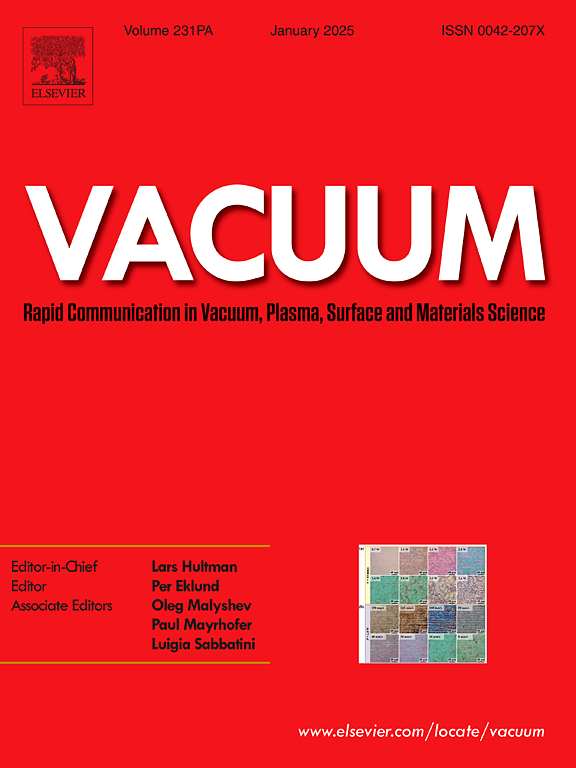Vacuum system of the HEPS storage ring
IF 3.9
2区 材料科学
Q2 MATERIALS SCIENCE, MULTIDISCIPLINARY
引用次数: 0
Abstract
HEPS (High Energy Photon Source) is a 4th generation ring-based light source with a beam energy of 6 GeV and a beam current intensity of 200 mA. The HEPS accelerator consists of a linac, a booster, a storage ring, and three transport lines connecting the linac, booster, and storage ring. The storage ring serves as the core region of HEPS. In this paper, the characteristics of the storage ring vacuum system are reviewed, and the designs and fabrication approaches for some key vacuum components are detailed. The main challenges include the extrusion of thin-walled CuCrZr vacuum chambers and the application of NEG (Non Evaporable Getters) coatings on their inner surfaces. These are used to mitigate substantial heat loads induced by synchrotron radiation along the vacuum chamber walls and provide an effective pumping speed for conductance-limited vacuum pipes with an inner diameter of 22 mm. The installation of the storage ring vacuum system started in November 2023, and finished in July 2024. Vacuum sectors were in-situ baked and activated for NEG films in the vacuum chambers, an average static pressure of 3 × 10−8Pa has been reached, which is better than the specification. These results confirm the feasibility of the storage ring vacuum system, covering aspects from the design and fabrication of components such as vacuum chambers, RF shielding bellows, and photon absorbers to processes like NEG coating via magnetron sputtering, installation, and in-situ activation of NEG films. After more than 20 days of conditioning, the beam current of the HEPS storage ring reached 12 mA, marking a milestone progress in the HEPS accelerator. At present, the accumulated beam dose is about 30 Ah (Jan.2025), the vacuum system performs well, the dynamic pressure of the storage ring is expected to decrease with the increase of accumulated beam dose.
真空系统的HEPS储存环
高能光子源(HEPS)是第四代环形光源,光束能量为6 GeV,光束电流强度为200 mA。HEPS加速器由直线加速器、升压器、存储环和连接直线加速器、升压器和存储环的三条传输线路组成。存储环是HEPS的核心区域。本文综述了存储环真空系统的特点,详细介绍了一些关键真空元件的设计和制造方法。主要挑战包括挤压薄壁CuCrZr真空室和在其内表面应用NEG(非蒸发吸收剂)涂层。这些用于减轻由同步辐射沿真空室壁引起的大量热负荷,并为内径为22毫米的电导限制真空管提供有效的抽速。储存环真空系统的安装于2023年11月开始,2024年7月完成。在真空室中对NEG薄膜的真空扇区进行原位烘烤和活化,平均静压达到3 × 10−8Pa,优于规格要求。这些结果证实了存储环真空系统的可行性,涵盖了从真空室、射频屏蔽波纹管和光子吸收器等组件的设计和制造,到通过磁控溅射、安装和NEG膜的原位活化等工艺。经过20多天的调理,HEPS存储环的束流达到了12 mA,标志着HEPS加速器取得了里程碑式的进展。目前,累积束流剂量约为30 Ah(2025年1月),真空系统性能良好,贮存环动压力有望随着累积束流剂量的增加而降低。
本文章由计算机程序翻译,如有差异,请以英文原文为准。
求助全文
约1分钟内获得全文
求助全文
来源期刊

Vacuum
工程技术-材料科学:综合
CiteScore
6.80
自引率
17.50%
发文量
0
审稿时长
34 days
期刊介绍:
Vacuum is an international rapid publications journal with a focus on short communication. All papers are peer-reviewed, with the review process for short communication geared towards very fast turnaround times. The journal also published full research papers, thematic issues and selected papers from leading conferences.
A report in Vacuum should represent a major advance in an area that involves a controlled environment at pressures of one atmosphere or below.
The scope of the journal includes:
1. Vacuum; original developments in vacuum pumping and instrumentation, vacuum measurement, vacuum gas dynamics, gas-surface interactions, surface treatment for UHV applications and low outgassing, vacuum melting, sintering, and vacuum metrology. Technology and solutions for large-scale facilities (e.g., particle accelerators and fusion devices). New instrumentation ( e.g., detectors and electron microscopes).
2. Plasma science; advances in PVD, CVD, plasma-assisted CVD, ion sources, deposition processes and analysis.
3. Surface science; surface engineering, surface chemistry, surface analysis, crystal growth, ion-surface interactions and etching, nanometer-scale processing, surface modification.
4. Materials science; novel functional or structural materials. Metals, ceramics, and polymers. Experiments, simulations, and modelling for understanding structure-property relationships. Thin films and coatings. Nanostructures and ion implantation.
 求助内容:
求助内容: 应助结果提醒方式:
应助结果提醒方式:


